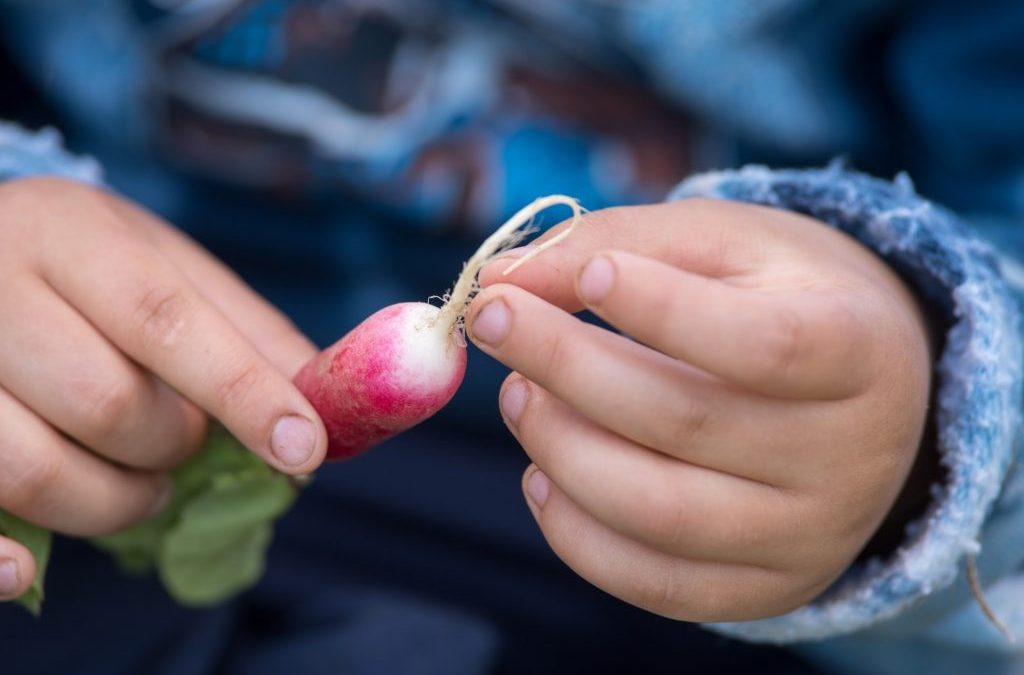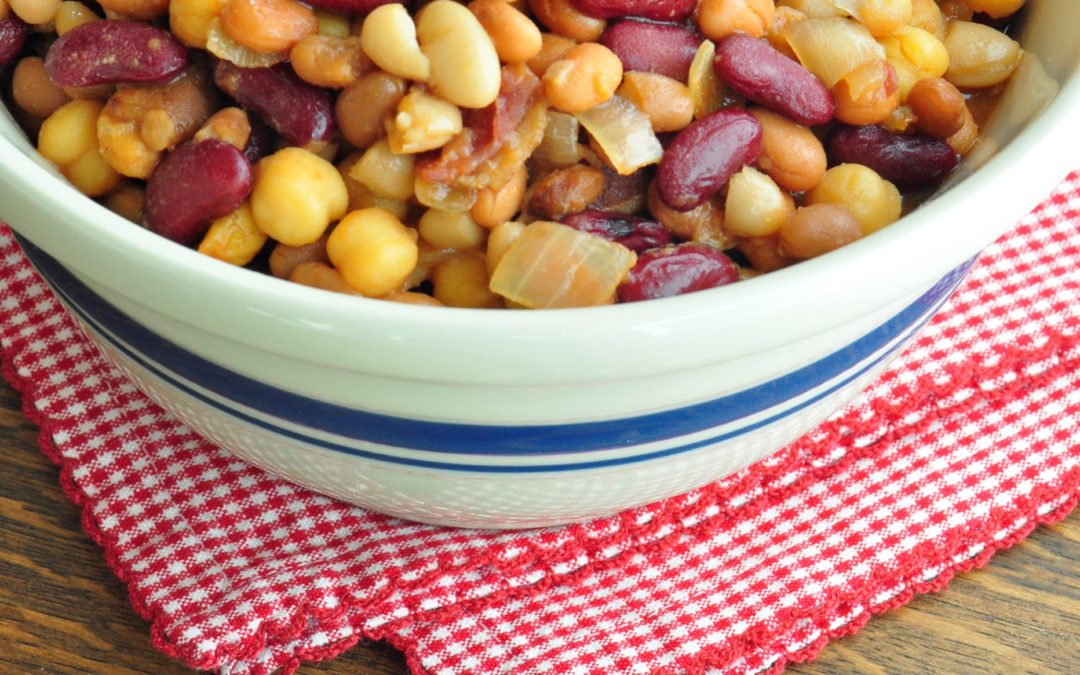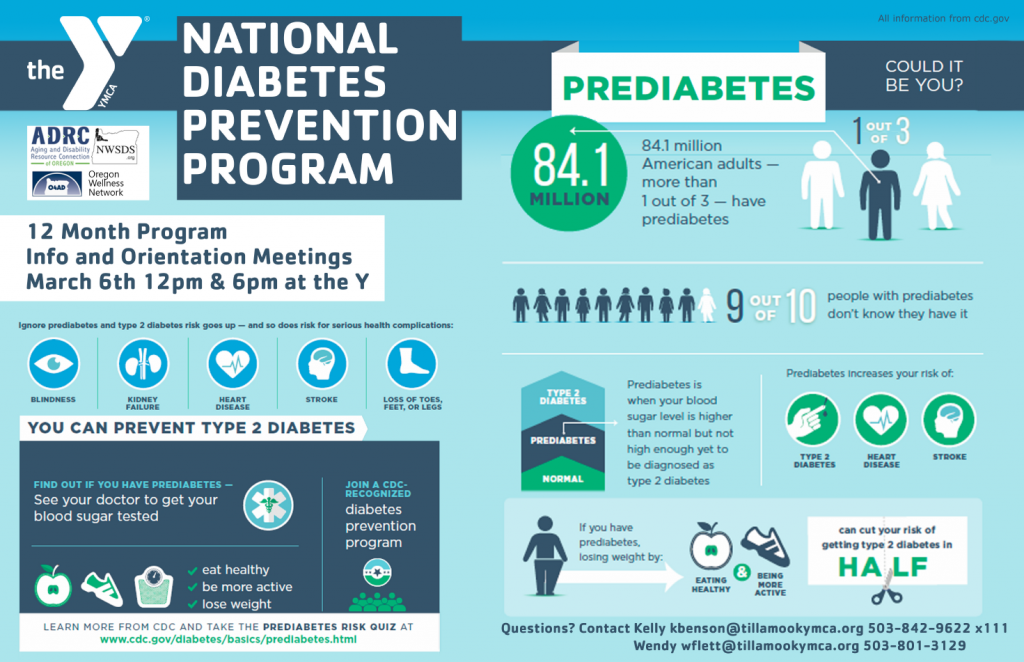
by Michelle | Oct 18, 2018 | Eat Well
By Rachel Pettit, Food Roots’ Farm to School Program Coordinator
What is farm to school?
Hands in the soil.
Seeds. Sprouts. Fruit.
Sharing and not being afraid to try something new.
Laughter. Smiles. Teamwork.
Farm to school is also a general term used to describe work being done across the United States to connect students with local food and encourage the development of healthy lifestyle behaviors. Tillamook County is a community rich in agricultural tradition that should be celebrated and shared with children of all backgrounds, farm kid or not.
This agricultural tradition in Tillamook is both deep and wide. Many families hold dairymen and women close, but a full diet of locally produced foods is available if you know where to look. Fruit, vegetables, meat, fish, seafood, eggs, sheep’s and goat’s milk, dairy, honey, bread, teas, and herbs are all produced in our community. Farm to school seeks to connect students with as many of those producers as possible.
In addition to celebrating agriculture and local food, farm to school programs also provide students with exciting opportunities to explore the world. Children are curious and eager to try new things, especially if those things are outside or involve eating! Students who participate in farm to school activities get to spend part of their school day gardening, cooking, conducting science experiments, spending time on farms, talking with local farmers who visit the classroom, and tasting all different kinds of produce.
Their seeds may not always grow, they may get a little messy, they may not love kale, but all of these students are building lifelong skills and relationships with their neighbors in the process.
In the spring, classrooms at Nehalem Elementary School, Garibaldi Grade School and South Prairie Elementary School hosted visiting farmers including Moon River Farm and Green Fork Farm both in Nehalem, and Leuthold Dairy, Wilson View Dairy, Zweifel Farm Eggs, and Zweifel Custom Farming who all call Tillamook home. In May, two classes of students from Nehalem Elementary School spent part of their school day on a field trip to Nehalem River Ranch. This summer, students from Nestucca Valley Elementary School harvested 100 pounds of produce and sold it at the Pacific City Farmers Market. Throughout the course of the 2017-2018 school year, students at seven schools in Tillamook County tasted new foods grown by local farmers.
Farm to school programs may be small, but they have big impacts on a community’s health and economy. Students who participate are more likely to eat fresh fruits and vegetables at school and are more likely to ask for extra veggies at home. They do better in school, especially in science, and have positive behavior changes. Farmers gain exposure, and families learn where they can buy local foods.
School gardens and Food Roots’ farm to school program are part of student life at Nehalem Elementary, Garibaldi Grade School, South Prairie Elementary, Tillamook Junior High, Nestucca Valley Elementary, and Neskowin Valley School. Grant funding from the Oregon Department of Education, and our partnership with national service organization FoodCorps help us provide regular farm to school lessons that complement what students are already learning in science, math, English, language arts, and social studies.
Our favorite lessons are out in the garden planting and caring for vegetables, or cooking simple, tasty recipes in the classroom with local produce. We also conduct regular all school Tasting Tables, participate in school Family Nights, help maintain school gardens, organize field trips to local farms or farmer visits to classrooms, and we run the School to Market project where students grow produce and sell it at market.
This year is also our second annual participation in National Farm to School Month, an October celebration that helps recognize farm to school programs like ours. We’re marking this season of abundance by harvesting the last of school garden produce and planting vegetables that will grow slowly through the winter for spring eating.
We’ll also be hosting a Tasting Table at each of our partner schools for students to try a special potato variety called the Makah Ozette fingerling. This variety of potato was never cultivated in Europe and made its way from the Andes Mountains to the Pacific Northwest via overland trade routes over hundreds of years. Food geneticists have proved this through recent testing, and we purchased the seed potatoes from a farm in Oregon City. Students planted the seed potatoes at the end of the school year and harvested the mature potatoes in September. Now they’ll be able to eat the fruits of their labor and learn a little bit more about how the foods we eat today carry generations of stories. A truly special celebration!
The final way we’re marking National Farm to School Month is with Local Food Open Houses, where school district families have an opportunity to try locally grown products and get to know local growers! Watch the Food Roots website or Facebook page for event announcements.
For more information about Farm to School Month, volunteering with school gardens, hosting students on your farm, or anything at all related to farm to school in Tillamook, please contact Rachel Pettit, Food Roots’ farm to school program coordinator, at rachel@foodrootsnw.org .

by Guest | Jun 15, 2018 | Eat Well
June is Dairy Month! Here in Tillamook County, we have a lot to celebrate. Our friends at the Oregon Dairy and Nutrition Council have provided us with an update on the topic of dairy fat.
Dairy fat has been in the news lately. Headlines say saturated fat is ok and that’s caused a bit of confusion, especially when some health recommendations still call for fat free and low fat. What do the experts say?
Besides being delicious, dairy foods are also an irreplaceable part of a healthy diet because they are packed with protein, calcium, and lots of other important vitamins and minerals. The 2015-2020 Dietary Guidelines for Americans recommend eating low-fat or nonfat dairy foods for everyone. But is there room for the higher fat dairy foods like whole milk, whole milk yogurt, cheese, and ice cream in your diet?
To answer that question, let’s begin by exploring the current science of fats and dairy fat.
First, your body needs fat for energy and growth. Fat helps us absorb some vitamins and also produces hormones that are important to our bodies. There are different types of fats and foods contain mixtures of different fats. Saturated fats are one type of fat found in animal fats such as meat and dairy foods, and some plant based fats such as coconut and palm.
What do we know about saturated fat?
For more than 70 years, scientists have linked diets high in saturated fat and cholesterol to an increased risk of heart disease (Dennett). Recently this conclusion is being challenged by scientists. We reported a couple of years ago on the newer research showing saturated dairy fats may not be linked to heart disease in healthy adults. (Link to May 2016 Wellness article “The Whole Truth about Dairy Fat”) Let’s look at what we know now in 2018.
What have scientists found in the past couple of years?
There have been some recent, interesting studies looking at the effects of dairy fat on the risk of developing heart disease (Miller). A 3 week study done in Denmark of 17 healthy adults found that drinking about 2 cups of whole milk a day instead of skim milk did not increase markers for heart disease: total cholesterol, LDL cholesterol, or triglycerides. Also, drinking whole milk instead of skim milk increased the good HDL-cholesterol. (Engel)
A review of dairy and heart health found there was no evidence that eating dairy foods is bad for heart health. Full fat dairy foods were found to be neutral in terms of risk of heart disease (Drouin-Chartier). Maintaining a healthy weight is important for adults and a cup of whole milk does have 70 more calories than a cup of skim milk. But this research suggests that if foods and physical activity are balanced to maintain weight, whole milk can be a part of the diet of healthy adults. (Engel)
Researchers now consider saturated fat as a very large category of different substances. They have questioned the connection that all saturated fats influence the risk of heart disease in the same way. (Mozaffarian) About two-thirds of the fatty acids in milk are saturated fat and there are more than 400 types of fatty acids in milk (Dennett). A 2012 study looking at different saturated fat-rich foods, found dairy fat was associated with less risk of heart disease than other saturated fat-rich foods (De Oliviera).
So how do dairy foods fit in my diet?
Can I eat ice cream, butter, and cheese? The simple answer is, yes. Dairy foods are an important source of protein, calcium, vitamin D, and other nutrients. Three servings of dairy foods a day are part of a healthy eating pattern which also includes eating a variety of vegetables, fruits, whole grains, and lean proteins.
The foods you choose are one part of a healthy lifestyle. Other important factors are maintaining a healthy weight, being physically active, not smoking, and drinking alcohol in moderation. Leading a healthy lifestyle will help us prevent chronic diseases like heart disease and diabetes.
So stay tuned for more research on saturated fats. Focus on your lifestyle choices and enjoy nutritious dairy foods of varying fat contents (including a little ice cream) along with vegetables, fruits, lean proteins, and whole grains.
References:
Dennett C. 2016. The truth about dairy fats. Today’s Dietitian. 18 (10): 26.
http://www.todaysdietitian.com/newarchives/1016p26.shtml
De Oliveira Otto MC, Mozaffarian D, Kromhout D, et al. 2012. Dietary intake of saturated fat by food source and incident cardiovascular disease: the Multi-Ethnic Study of Atherosclerosis. Am J Clin Nutr. 96 (2): 397-404.
https://www.ncbi.nlm.nih.gov/pmc/articles/PMC3396447/
Drouin-Chartier JP, Brassard D, Tessier-Grenier M, Cote JA, Labonte ME, Desroches S, Couture P, Lamarche B. 2016. Systematic review of the association between dairy product consumption and risk of cardiovascular-related clinical outcomes. Adv Nutr. 7 (6): 1026-1040. https://academic.oup.com/advances/article/7/6/1026/4568635
Engel S, Elhauge M, Tholstrup T. 2018. Effect of whole milk compared with skimmed milk on fasting blood lipids in healthy adults: a 3-week randomized crossover study. Eur J Clin Nutr. 72 (2): 249-254. https://www.ncbi.nlm.nih.gov/pubmed/29229955
Guest. TillamookCountyHealthMatters.org. June 23, 2016. The “Whole” Truth about Dairy Fat. http://tillamookcountyhealthmatters.org/the-whole-truth-about-dairy-fat/
Miller G. National Dairy Council. February 27, 2018. Whole Milk Dairy Foods: Exploring the Evolving Science. https://www.nationaldiarycouncil.org/content/2018/milk-fat-exploring-the-evolving-science
Mozaffarian D. 2016. Dietary and policy priorities for cardiovascular disease, diabetes, and obesity: a comprehensive review. Circulation.133 (2): 187-225.
http://circ.ahajournals.org/content/133/2/187.long

by Guest | Jun 1, 2018 | Eat Well, Recipes
Recipe Source: Recipe and photo from www.FoodHero.org
Number of servings: 16
Time for preparation (including preparation and cooking): 1 hour 45 min
Ingredients:
6 slices bacon
1 cup chopped onion
1 clove garlic, minced or 1/4 teaspoon garlic powder
1 can (15 ounces) pinto beans, drained and rinsed
1 can (15 ounces) great northern beans, drained and rinsed
1 can (16 ounces) kidney beans, drained and rinsed
1 can (15 ounces) garbanzo beans, drained and rinsed
1 can (15 ounces) pork and beans
3⁄4 cup ketchup
1⁄4 cup molasses
1⁄4 cup brown sugar
2 Tablespoons worcestershire sauce
1 Tablespoon prepared mustard
1⁄4 teaspoon pepper
Directions
- Preheat oven to 375 degrees.
- Cut bacon into bite sized pieces and place in skillet. Cook over medium heat (300 degrees in an electric skillet) until evenly browned. Remove from pan and set aside.
- Drain skillet, reserving 1 teaspoon of drippings. Add onion and garlic. Cook until onion is tender. Remove from skillet and add to bacon. Discard remaining drippings.
- Mix beans with bacon, onion, and garlic. Stir in remaining ingredients.
- Transfer to a 9×12 baking dish or 3 quart casserole dish. Bake in a preheated oven for 1 hour.
- Refrigerate leftovers within 2 hours.
Notes
- Use any mix of beans you have.
- Cook your own dry beans. One can (15 ounces) is about 1 1/2 to 1 3/4 cups drained beans.
- No bacon? Use 1 teaspoon cooking oil to saute vegetables.

by Guest | Mar 23, 2018 | Being Well, Eat Well
By Laura Swanson
“I’ve been doing some research,” said Dr. Mark Bowman, Medical Officer at Adventist Health Tillamook Regional Medical Center, “And I can send you the studies,” he added, as we continued our conversation about why the Year of Wellness focus on type 2 diabetes prevention is so important. “The statistics are interesting and according to the research, having diabetes is equal to having heart disease,” Bowman stated. “The risk to your health is equal to having previously had a heart attack; that’s the impact that diabetes has on the body.” That’s why it’s important to control diabetes as it lowers the risk for complications.
As Dr. Bowman continues his practice of Functional Medicine, which focuses on the individual and finding the underlying causes for symptoms, ongoing and leading edge research provides a basis, but research is done with a tightly controlled group. “It’s almost impossible to replicate the conditions of a research group in reality,” explains Bowman. It’s an incomplete puzzle with different individual responses. Other systems that are impacted by diabetes, in addition to the increased risk for coronary disease are macro-vascular, kidney disease, retina deterioration, neuropathy, and hypertension.
Diabetes symptoms can be controlled with medication, but lifestyle changes are the “key and safest” medicine for slowing, and even reversing diabetes. “You can have a patient on insulin therapy for decades, but in most cases, the pancreas eventually loses the ability to continue producing high levels of insulin. Insulin resistance occurs at the cellular level,” explained Dr. Bowman.” It signals the body to increase fat cells and more insulin is required …it’s a vicious circle.” He continued, “When you make some simple lifestyle changes such as healthier eating and activity, you can delay and even reserve insulin resistance. It’s not easy for some people, and an individual approach is necessary.” That’s why Dr. Bowman is focusing on Functional Medicine. “It’s not a one-size-fits-all kind of medicine,” he added.
“The research is constantly being done and the findings continue to change our treatment options,” said Dr. Bowman, as he prepared to head to New York City for the Integrative Healthcare Symposium. “We are hearing more references to dementia and Alzheimer’s as ‘type 3’ diabetes,” said Dr. Bowman. “The impacts are micro-vascular and there is a link between reducing inflammation and improving systems functions. You can delay the progression with anti-inflammatory foods.” There it is again – “Food as medicine.” It’s more than an apple-a- day, according to Dr. Bowman, “Eat and drink as ‘clean’ as possible, reduce exposure to internal and external chronic stress. Seventy-percent of serotonin (the neurotransmitter chemical that impacts mood and more) is produced by the bacteria in the gut.”
Then there are those pesky genes and again how each individual’s systems function. One study looked at ways of reducing the complications of diabetes, with findings that an A1C level under 7 reduced onset of other chronic problems. It involved intensive lifestyle therapy, not medication. “There is current dialogue about diet and diabetics,” said Bowman. “Lower carb, plant-based. It’s all about reducing sugar, and carbohydrates and grains that metabolize into sugar.” Dr. Bowman was most looking forward to a presentation by Dr. Mark Hyman (A leader in Functional Medicine), “Food: What the Heck Should I Eat?” – which is also the title of his newest book. Our next interview with Dr. Bowman will be about the NYC symposium.
“We can continue to increase awareness and educate about lifestyle changes,” said Dr. Bowman. “encourage people to make healthier choices, develop particular ways and habits that have positive impacts on their quality of life.” He continued, “We get a label as diabetics, and internalize, suffering shame because ‘we must have done something wrong.’ By talking about diabetes, and many chronic diseases such as hypertension, lipid, and hormonal imbalances we can let people know there are ways to turn it around. Don’t suffer in silence, or simply, Band-aid with a pill.” He continued, “It’s an individual life journey and there’s a time and place for all tools. Increased awareness and acceptance of the different lasting options will ultimately help patients enjoy a satisfying life.”

by Guest | Mar 2, 2018 | Being Well, Eat Well
By Sara Todd, LCSW, Rinehart Clinic
The shame experience is complex and holds a variety of feelings. Shame can be debilitating and all encompassing. Eye contact may feel painful, even impossible. At its worst, it can result in withdrawing from the world. A retreat into a darkness that feeds upon itself.
Shame is triggered by an external event and this can even include receiving the diagnosis of a medical illness, such as diabetes. The diagnosis may trigger shame because of feeling exposed as inadequate or incapable. A person may feel they don’t “measure up” to an ideal. The diagnosis can end up confirming what someone already feels about her or himself— that they are flawed or not good enough.
Shame has a social context and occurs in relationship with others. We will say, you shamed me. A tendency toward shame in one’s adult life may come from early experiences of being judged, ridiculed and not fully celebrated and enjoyed by one’s caregivers. This fundamental sense of “badness” repeats a cycle that originated in one’s early life. For some, shame may be a foundation underlying everything one does. Diabetes is just one more channel for that shame.
Shame thrives in darkness and loathes the light. Its antidote is radical acceptance, the full embrace of love and kindness by another and towards oneself.
Because diabetes intersects with a person’s relationship to their body, their relationship to food and eating and the authority of medical providers, it makes sense that all of this would trigger a shame response. The combination of society’s unrealistic beauty standards, feeling constantly “graded” through daily monitoring of blood glucose or A1c tests and the way we ignore the institutional reasons for challenges such as poverty and eating healthy, all contribute to an internal dialogue of “I did this to myself”.
What is the way out?
The first may be to have curiosity about the shame. Ask questions about the feeling and the storyline that you’re “not good enough.” Why do I feel ashamed about having diabetes? Open it up for exploration. If the shame is connected to not measuring up to an ideal version you have of yourself, you can ask: Who set that standard? Is this an ideal that comes from my own values or someone else’s?
Questioning the self-blame can also be effective. What may be other reasons I have this disease? Why else did it happen? Is there a family history, for example? The point is not to deflect accountability, but to bring a more complex understanding.
We can also begin to unravel this knot of humiliation, self-hate, and feeling outcast by “dropping the storyline.” When these thoughts “I’m not good enough…I did this to myself…I’ll never get it right” come up, take a deep breath, feel your body and then let the thoughts go. A teacher once gave me the tool of: Recognize-Refrain-Relax-Remain. Recognize that you are getting caught again in the feelings and thoughts of shame. Refrain from trying to escape the feelings (don’t numb out). Relax by deep breathing, stretching, taking a walk or simply just letting yourself be. And, finally, remain where you are in that moment. It will pass.
If shame is making it difficult to engage deeply with others and live your life fully, talking to a therapist may also be a good idea. Shame that originates in trauma needs healing with a licensed mental health professional. And as we heal the wound of shame, we begin to love ourselves more fully through the gift of improved health.
Most importantly, shed light on that shame because you, at your core, are good and perfect just as you are.

by Michelle | Feb 23, 2018 | Being Well, Eat Well
By Michelle Jenck, YOW Coordinator
If it seems like you have been hearing a lot about diabetes and pre-diabetes lately, you are right. At the risk of over-sharing, the Year of Wellness team wants to make sure Tillamook County residents are getting the message – loud and clear. A lot of people have prediabetes and there IS something we can do about it.
Our YOW partners at the Y and Northwest Senior & Disability Services are teaming up to prevent diabetes in Tillamook County. This infographic highlights key risk factors and prevention methods. Losing even a few pounds (and keeping them off) can help most people reverse their risk of developing type 2 diabetes. The best way to do that is to follow healthier eating habits and become more physically active than you are right now.
Because we know change can be difficult, our YOW partners are working to provide community-based supports to make these changes easier. Diabetes Prevention Program (DPP) classes are one way to learn about healthy habits and how you can adapt your lifestyle to optimize health. Plan to attend the DPP orientation, March 6th at either 12:00 noon or 6 p.m. at the YMCA, 610 Stillwell Avenue in Tillamook. You have nothing to lose (but weight) and everything to gain (in health)!
Continue to follow us in the Headlight-Herald each week to learn more about local resources available to you and your family. Visit our website at tillamookcountyhealthmatters.org or download the app, Tillamook County YOW, for additional community-based wellness resources and information.






